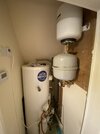- Joined
- 2 Feb 2023
- Messages
- 3
- Reaction score
- 0
- Country

Hi first time post, and appreciate some of the steps below that have already been taken are not standard procedure but I was wondering if anyone here had an interpretation or advice.
Have a 3 storey house with a system boiler, 17 radiators in total fed by microbore pipe, with boiler (Ideal H24) on ground floor and hot water tank, central heating pump and 2x expansion tank setup in the airing cupboard on the top floor. System pressure is 1.5bar, never had any issues with this.
Two of the radiators in the house have never got warm, one on the top floor and one on the ground floor. On each the entire radiator is cold, as is the inlet + outlet pipe. When we moved in a plumber came, turned the bleed key on each radiator, water spurted out and after a few seconds of bleeding they proclaimed that it must be a blockage in the microbore pipes somewhere. They said a powerflush wasn't possible on microbore, the pipe would have to be 'traced back' through the plasterboard - big, expensive and messy job so we just accepted the radiators wouldn't work.
Recently I decided to bleed the radiator with the central heating system operating and keep going until the water stopped coming out of the radiator, or until hot water started flowing (I realise this isn't advised...).
After bleeding about 2L of water from each radiator, the water coming out became hot, the radiator heated up and the microbore inlet pipe became hot to the touch - just like the other radiators in the house. However when the bleed screw was put back in place, the radiator cooled down and the inlet pipe became cold again.
Am I correct in thinking that there is likely no blockage in the pipe and this is instead a radiator balance issue? Does anyone with any experience have any ideas on where to go next? I am unsure about the 'drops' or layout of the central heating pipes behind the plasterboard in my house, but would be happy to provide this info if someone could help me work it out.
Not sure if it helps, but photograph of airing cupboard set up attached.
Many thanks in advance for any help.
Have a 3 storey house with a system boiler, 17 radiators in total fed by microbore pipe, with boiler (Ideal H24) on ground floor and hot water tank, central heating pump and 2x expansion tank setup in the airing cupboard on the top floor. System pressure is 1.5bar, never had any issues with this.
Two of the radiators in the house have never got warm, one on the top floor and one on the ground floor. On each the entire radiator is cold, as is the inlet + outlet pipe. When we moved in a plumber came, turned the bleed key on each radiator, water spurted out and after a few seconds of bleeding they proclaimed that it must be a blockage in the microbore pipes somewhere. They said a powerflush wasn't possible on microbore, the pipe would have to be 'traced back' through the plasterboard - big, expensive and messy job so we just accepted the radiators wouldn't work.
Recently I decided to bleed the radiator with the central heating system operating and keep going until the water stopped coming out of the radiator, or until hot water started flowing (I realise this isn't advised...).
After bleeding about 2L of water from each radiator, the water coming out became hot, the radiator heated up and the microbore inlet pipe became hot to the touch - just like the other radiators in the house. However when the bleed screw was put back in place, the radiator cooled down and the inlet pipe became cold again.
Am I correct in thinking that there is likely no blockage in the pipe and this is instead a radiator balance issue? Does anyone with any experience have any ideas on where to go next? I am unsure about the 'drops' or layout of the central heating pipes behind the plasterboard in my house, but would be happy to provide this info if someone could help me work it out.
Not sure if it helps, but photograph of airing cupboard set up attached.
Many thanks in advance for any help.

